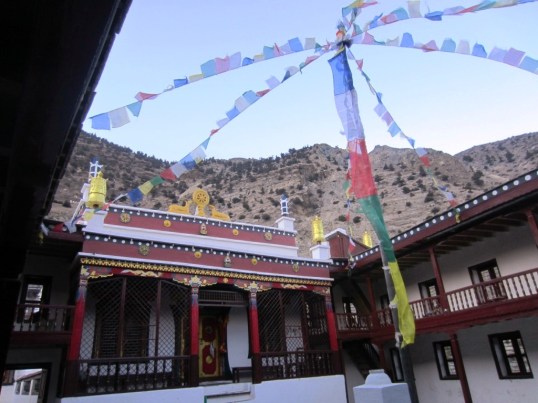You-tube Video: All-women trekking in Nepal with Three Sisters (and me!)
Check it out! Here is the link on You-Tube:
Check it out! Here is the link on You-Tube:
During this day’s transition from Kathmandu, Nepal to Chiang Mai, Thailand, DM and I broke every rule of the experienced traveler, including:
1. Allow plenty of extra time to get to the airport in case of traffic.
“Our international flight is at 1:30PM; let’s arrange for a taxi at 10:30” say I.
“Oh, that’s silly,” says DM. “It’s only a 20 minute ride to the airport – make it 11:AM.” I didn’t feel like arguing, and also refrained from saying “I told you so” when the taxi arrived 20 minutes late, and traffic was horrendous.
2. Besure to check that you have all your belongings before leaving the hotel.
Three blocks into the noon-time traffic of Kathmandu, DM shrieks “Oh No! I left my purse on the couch in the hotel lobby – we have to go back.” Fortunately, the taxi driver knew a back street, and the purse was still there. And even more fortunately, the plane was a bit late.
3. Be sure to check the rules about currency exchange if you have any significant amount of local currency left.
I had about $70 US in Nepalese rupees, which I decided in our hurry not to pause to exchange at the airport in Nepal. It was only when I got to the US and tried to exchange that I found out that it is “illegal” to take NPR out of Nepal, and no other country will exchange the currency.
4. Be sure to check that you have all your belongings before leaving the plane.
I stepped aside to check the connecting flight number as we waited to exit the plane; only after we were halfway up the concourse (fortunately, still within the security area) did I realize my backpack was too light – I had left my fanny pack/purse on the airplane seat. I swam upstream against the flood of exiting passengers to retrieve it, and we loped through the concourse to catch our flight rather than making our anticipated R&R stop in the Thai Airways Orchid Lounge.
5. Be sure you have some local currency in hand on arriving in a new country.
We had planned to grab some Thai currency in the Bangkok airport, but had no time between flights due to flight delay and my brain-dead episode. By the time we arrived in Chiang Mai, the ATMs and currency exchange booths were shut down for the night. Fortunately, DM’s neighbor had given her a few leftover baht to use as mad money – just enough to pay the taxi to our hotel.
So yes, we knew better. God watches over fools. We got there anyway.
This morning the weather in both Jomsom and Pokhara has turned overcast, foggy, and damp, so no planes are flying. The town is swarming with folks who wanted to fly and are now seeking wheels. We fall back on Alternative Transport to cover the ~ 90 miles. Flying would take less than 60 minutes. Alternative Transport? In Nepal that means
Stage 1 – Jomsom to Ghaza – Bina, our guide, manages to secure a jeep – one of the standard white made-in-India models, with blue tarp duct-taped over the space where the rear window used to be, clear packaging tape overlying the spider-web of cracks in the windshield, and a roll of duct tape for emergencies hung on the gearshift lever. The Nepalese standard usage is a minimum of 14 people plus baggage. Happily, our resourceful guide hired the jeep for the seven of us, paying for the extra phantom 7 people at the Nepalese rate – 140 NR/person, or an extravagant $12.50 extra. We got puzzled and disappointed looks all up the road from folk who wanted to flag down the jeep and fill the empty spaces.
We departed at about 8 AM. Just out of town we stop to top off the gas tank. No gas pump – just a five-gallon plastic jug full of gasoline and a siphon. It’s primitive but it works.
About 5 Km into the journey, we make an unscheduled stop: the driver hops out and greets an elderly woman carrying a plastic bag full of garlic. He examines the garlic, shakes his head, discards some of the more dubious roots, then slings the bag into the back of the jeep on top of our packs.
 Another 5 KM – a very unusual sound comes from underneath the floor of the jeep, and the engine stops. Within 5 minutes there are two buses headed the other way which have been forced to stop, their two drivers are standing around our jeep offering advice to our driver, who is underneath the jeep with a monkey wrench. After about 15 minutes he emerges, wipes his hands on the grubby towel he had been lying on, and we proceed with cheering from our group.
Another 5 KM – a very unusual sound comes from underneath the floor of the jeep, and the engine stops. Within 5 minutes there are two buses headed the other way which have been forced to stop, their two drivers are standing around our jeep offering advice to our driver, who is underneath the jeep with a monkey wrench. After about 15 minutes he emerges, wipes his hands on the grubby towel he had been lying on, and we proceed with cheering from our group.
Another 5 KM – The driver stops again and a young woman runs up to the jeep. He brings out the garlic, and gets a big smile from the happy homemaker.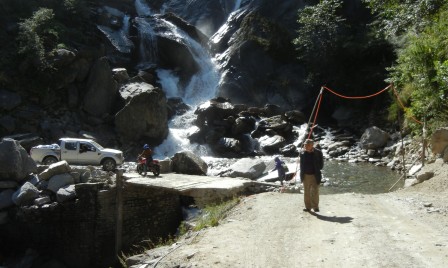
Stage 2 – We arrive at Ghansa about noon. The driver refuses to drive any further, as the bridge has washed out at the Rutche falls and there is no turnaround. So we resume our packs and hike for two hours, plus a lunch stop just after making our way over the washed -out bridge, until we get to Tithze (?) where we hope to hire another jeep. The walk is actually very pleasant – cool, bypassing the road, and it feels good after the hard seats and bouncy suspension of the jeep. But yet to come was
 Stage 3 – at Tithze, no jeep is available – all have been booked by folks who walked faster than we did. Bina books us on the next available bus, which was third in line to leave – again, the earlier buses had already filled with an eclectic collection of Tibetan refugee women in their colorful woven aprons, young Nepalese men in blue jeans, and a swarm of trekkers from Germany, France, Australia, the US, and many other points, in various stages of grunginess and grumpiness.
Stage 3 – at Tithze, no jeep is available – all have been booked by folks who walked faster than we did. Bina books us on the next available bus, which was third in line to leave – again, the earlier buses had already filled with an eclectic collection of Tibetan refugee women in their colorful woven aprons, young Nepalese men in blue jeans, and a swarm of trekkers from Germany, France, Australia, the US, and many other points, in various stages of grunginess and grumpiness.
Bina got us onto the bus as early as possible before its 3PM departure to make sure everyone had a seat – that was fine, until the additional folks started filling in the cracks. DM and DB and two Nepalese and two Frenchmen sat in the area in front of the partition that was designed to separate the driver from the passengers; I was packed into my seat unable to move my legs as they were wedged in between the spare tire, four back packs, and a violin case, plus assorted legs of fellow passengers. Fortunately, I had made an offering to Ganesha, the god of travellers, at the temple in Mulktinath, so we survived the trip, although DB had to exchange seats with Bina since she couldn’t stop herself from shrieking at every upcoming hairpin turn. We thought that the bus was crammed full, but that didn’t stop additional passengers from hopping aboard through the always-open side door – we accumulated three in the course of the ride, all of whom ended up sitting on the packs on top of the spare tire next to me.
The trip was eerily like living the previous week in reverse, as if the tape of my life were being rewound. We went through all the small towns – “Ah, there’s the Dutch Bakery in Tubuche where we had that great carrot soup and brown bread!” “Look, there’s where you lost your hat!” We plunged down the gravel track traveling from barren scrub brush to pine forest to cherries in bloom to apple orchards laden with fruit to banana trees.
Three hours later, we made it to Bema, and
Stage 4 – the SUV from 3 Sisters arrived to carry us the rest of the way – three more hours in the dark and rain (of course it would rain!) on roads not much better than the “drivable gravel roads” we had been on. We keep ourselves awake and alert by trading songs with the Nepalese guides: DB, DM and I harmonize on “You Are My Sunshine”, and the girls in the back respond with a Nepalese folk tune that involves a considerable amount of finger-snapping and tongue-clicking. We come back with a round of “White Coral Bells.” We get through our entire repertoire of 1960’s Girl Scout Camp songs before finally in the last hour we hit blacktop!
At 10PM we reached the 3 sisters guest house, where they insisted on serving us our Farewell Dinner – dal bhat, of course. Then we thankfully hit the cozy beds. Tomorrow we will enjoy hot showers and full-size towels, then DM and I will hit the road back to Kathmandu. Next stop – Thailand! 
The last day of the trek is a 5 hour hike from Mulktinath to Jomsom, partly across a rocky river bed along the bus road going into the sun and a cold wind. DB took the jeep again, as she has had a lot of trouble coping with the altitude.
DM and I were apprehensive about the dusty, rocky riverbed section of the trail, remembering how un-happy the trekkers on that path had looked when we had passed them in the jeep two days before. However, our guides led up to the high path away from the road going from Mulktinath toward Jomsom, which cut out a lot of the riverbed section.
 The first section of the road retraced our path back toward Kagbeni, but then it branched up over the shoulder of the hill so we looked at Kagbeni far down in the basin of the valley with snowy peaks rising in all directions. In the distant downhill we could see the small nameless town where we would have our tea break. We passed a herd of domesticated mountain goats, built low to the ground with long shaggy coats of black, tan, or a splotched blend of both. Each had one horn painted blue to show the ownership. They munched eagerly on thorny gray scrub bushes which I would be ashamed to put in the recycling, much less use to sustain life.
The first section of the road retraced our path back toward Kagbeni, but then it branched up over the shoulder of the hill so we looked at Kagbeni far down in the basin of the valley with snowy peaks rising in all directions. In the distant downhill we could see the small nameless town where we would have our tea break. We passed a herd of domesticated mountain goats, built low to the ground with long shaggy coats of black, tan, or a splotched blend of both. Each had one horn painted blue to show the ownership. They munched eagerly on thorny gray scrub bushes which I would be ashamed to put in the recycling, much less use to sustain life.
At tea break, we talked with an Australian and a couple from the UK who had just come down from the high pass at Thorung La (5540 M). The lady said “I just looked at Sindu’s feet and followed where they went.” I congratulated her, but thought privately “Don’t forget to look up – it’s why you’re here!”
From this comfortable spot we continued down to the riverbed, the road barely discernible and the wind picking up as promised. But the traffic was light – one tractor, two jeeps, two scooters, a half-dozen trekkers. The wind was cool, the sun was welcome. My new hat, pulled down tightly over my hood, blew off only once; the shoelace cord I had contrived to secure it was so inextricably tangled in my camera lanyard that no harm was done.
 The hill trail cut half the distance between Jomsom and Kagbeni – we arrived in Jomsom in good spirits, but with the fog closing in. On the good side, fog in Pokhara had prevented flights into Jomsom, so the premier guest house was able to find room for us despite having been fully booked when we checked on our way to Mulktinath. On the downside, the hardest stretch of the day was getting from the near side of town – the jeep park – to the far side of town where this hotel was located. (Strange but true – no matter which direction you are going, your hotel is always on the far side of town.) My feet protested each step on the cobbled street, which seemed to stretch on forever. We finally made it to the Majesty Hotel, complete with chandelier in the three-story atrium lobby (see earlier post). The service was slow, the internet connection was down, the ATM did not work, but all was excused: double blankets on the bed! Attached bathroom! And HOT SHOWER!
The hill trail cut half the distance between Jomsom and Kagbeni – we arrived in Jomsom in good spirits, but with the fog closing in. On the good side, fog in Pokhara had prevented flights into Jomsom, so the premier guest house was able to find room for us despite having been fully booked when we checked on our way to Mulktinath. On the downside, the hardest stretch of the day was getting from the near side of town – the jeep park – to the far side of town where this hotel was located. (Strange but true – no matter which direction you are going, your hotel is always on the far side of town.) My feet protested each step on the cobbled street, which seemed to stretch on forever. We finally made it to the Majesty Hotel, complete with chandelier in the three-story atrium lobby (see earlier post). The service was slow, the internet connection was down, the ATM did not work, but all was excused: double blankets on the bed! Attached bathroom! And HOT SHOWER!
This was supposed to be the last day on the trail, but… men make plans so the gods can laugh.
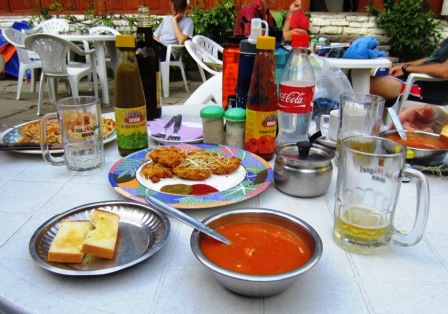 My basic tip is: don’t worry about it. If you are doing the Annapurna circuit you will not be far from a roof or a kitchen; BUT
My basic tip is: don’t worry about it. If you are doing the Annapurna circuit you will not be far from a roof or a kitchen; BUT
in the high season you WILL need reservations or risk sleeping on the dining room floor.
Other thoughts:

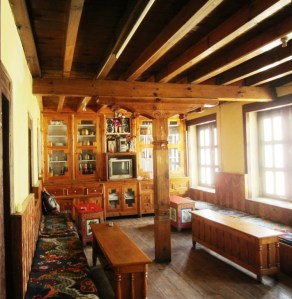


This was a very easy day, hiking only 45 minues up the hill from Jharkot to Mulktinath, where we stayed in a more primitive guest house (Asian-style toilets, 3 beds shoehorned into a room meant for two, one sink for all to use outside, pay-per-use propane-fueled shower) but with a fantastic 270-degree view of the peaks around. Mulktinath is a holy pilgrimage site for both Buddhists and Hindus, and has the requisite Vishnu temple, Buddhist gompa, and Buddhist nunnery.
 Since Mulktinath is almost the first point of civilization for people descending from the highest point of the full Annapurna circuit, it has also blossomed in the last few years (since the most recent Lonely Planet, even) with fancy new guest houses and scores of Tibetan refugees selling hand-woven belts, hand-knit hats, and scarves which may or may not be handwoven pashmina or yak fur.
Since Mulktinath is almost the first point of civilization for people descending from the highest point of the full Annapurna circuit, it has also blossomed in the last few years (since the most recent Lonely Planet, even) with fancy new guest houses and scores of Tibetan refugees selling hand-woven belts, hand-knit hats, and scarves which may or may not be handwoven pashmina or yak fur.
We ran the gauntlet of scarf-sellers and made it to the temple, where Bina, our guide, observed devotions and showed us how it is done. She and Bandana, one of the assistants, had brought empty plastic liter bottles and carefully filled them with water from each of the 108 spouting bull’s heads fountaining around the Vishnu temple. She also tied a lucky mallahi string around each of our necks and gave us each a tika – the red dot in the center of the forehead. 
We also were admitted to the most sacred site, which is an eternal flame burning from a natural gas vent next to an underground river – this combines the sacred elements of earth, air, fire, and water in a way which is thrilling to Hindus and Buddhists alike.
 The hills behind the site are a spider web of prayer flags; the path up to the site is lined with stones piled one atop another – these are believed to be homes provided for souls which have not yet found their way to judgment, so building a nice one for yourself in afterlife is a good investment of time – especially if you need to pause for breath while climbing the stairs at 3800 M.
The hills behind the site are a spider web of prayer flags; the path up to the site is lined with stones piled one atop another – these are believed to be homes provided for souls which have not yet found their way to judgment, so building a nice one for yourself in afterlife is a good investment of time – especially if you need to pause for breath while climbing the stairs at 3800 M.
 Following our descent and our mollifying the sellers by purchasing several scarves, necklaces, and whatnot, we made it back to the hotel for lunch. After lunch DM and I visited a Buddhist monastery (brand new and painted lavender, for some reason). Murals outside the shrine depict the “King of the North (China), yellow-skinned and standing on a panda. The King of the West is pale-skinned and stands on a Lion – influenced by early British contact, maybe? The King of the East (Tibet) stands on a tiger, while the King of the South – the Kathmandu region relative to Mulktinath – stands on an eland. Inside the shrine has the usual portraits of current and former Lamas, but the monastery is down to only five monks.
Following our descent and our mollifying the sellers by purchasing several scarves, necklaces, and whatnot, we made it back to the hotel for lunch. After lunch DM and I visited a Buddhist monastery (brand new and painted lavender, for some reason). Murals outside the shrine depict the “King of the North (China), yellow-skinned and standing on a panda. The King of the West is pale-skinned and stands on a Lion – influenced by early British contact, maybe? The King of the East (Tibet) stands on a tiger, while the King of the South – the Kathmandu region relative to Mulktinath – stands on an eland. Inside the shrine has the usual portraits of current and former Lamas, but the monastery is down to only five monks.
In town DM and I did our best to send some email. The young man who runs the internet café spends the winter months in Kathmandu playing in a band; in the trekking season he spotted an opportunity and set up the internet café in Mulktinath – but the connection is iffy before 6PM because of the limited power allowance in the mountains.
In the evening the three of us and two of the guides drug out a battered deck of cards and played gin rummy and a new game called “five-or-less” to great laughter. There is something universal about a deck of cards; I wish we’d discovered this sooner.
This day we again put DB on a jeep – this time first thing in the morning – and DM and I set out on foot for a four hour trek partly along the bus road (DB and Bina waved at us as they passed) and partly along the old trekking road. We had the three assistants as guides – nice young things with big smiles and minimal English – and we had a fine time walking through a series of small stone-built villages, over stone bridges, along an amazing series of conduits for flowing water (the actual river was way downhill from us). We shared trail mix and granola bars and rested frequently, but still made our destination in the four hours allotted.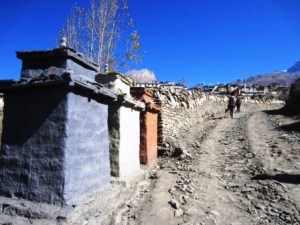
Jharkot is just a smidge(3500M) down the hill from Mulktinath, the high point of the trek (3802M according to my new hat). Since we arrived before noon, we had a leisurely lunch on the veranda looking at Nilghiri Peak across the valley, then explored the town, including an ancient Buddhist monastery dating back to the 700s, with some fascinating paintings and artifacts. We are amazed still at how cavalierly the Nepalese treat their history – no hesitation about touching a fragile old canvas, or allowing flash photos of an ancient wall mural. The town was very Tibetan in feeling, according to Dianne, who has been to Tibet, all gray stone and low doorways leading into dark corridors or bright courtyards; lots of Buddhist elements mixed in with ancient animist totems – very alien to us.
 We also had an impromptu tour of a women’s collective engaged inproducing seabuckthorn juice concentrate for the local market. (If seabuckthorn replaces the acai berries craze, you read it here first!) The women do everything from gathering, crushing, and simmering the berries for juice to scalding, labeling and filling recycled bottles for the market. The space for the seasonal operation is provided by the local Buddhist monastery; the proceeds are used to assist poor families in the village. (The catch is that much of the money goes back to the monastery to pay for religious services)
We also had an impromptu tour of a women’s collective engaged inproducing seabuckthorn juice concentrate for the local market. (If seabuckthorn replaces the acai berries craze, you read it here first!) The women do everything from gathering, crushing, and simmering the berries for juice to scalding, labeling and filling recycled bottles for the market. The space for the seasonal operation is provided by the local Buddhist monastery; the proceeds are used to assist poor families in the village. (The catch is that much of the money goes back to the monastery to pay for religious services)
 In the evening we gathered around the table under which a charcoal brazier radiated warmth, and after dinner ended up playing a Nepalese version of gin rummy with our guide Bina; assistant Bandana; Katharine, a Dutch management consultant who was trekking solo with a guide, and a charming Italo-French skydiving instructor named David who had just come over the Thang Lo pass solo – no guide, no porter. We had a lot of inter-generational, inter-cultural laughing and silliness, and at 8:30 the three of us decided it was past our bedtime and left the younger folk to it.
In the evening we gathered around the table under which a charcoal brazier radiated warmth, and after dinner ended up playing a Nepalese version of gin rummy with our guide Bina; assistant Bandana; Katharine, a Dutch management consultant who was trekking solo with a guide, and a charming Italo-French skydiving instructor named David who had just come over the Thang Lo pass solo – no guide, no porter. We had a lot of inter-generational, inter-cultural laughing and silliness, and at 8:30 the three of us decided it was past our bedtime and left the younger folk to it.
I was amazed at the ability of a battered deck of cards to erase boundaries – we need to play more often!
Here are some suggestions regarding equipment you will need for the Annapurna circuit trek, and my recommendations for the best way to manage it.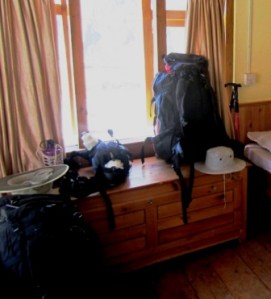

 This day is full of new sights, new surprises. Today I felt the foreignness of Nepal as I have not before. We have left the Hindu lowlands behind, and are now in the area settled a decade ago or more by Tibetan refugees. There is no lush greenery, no fertile croplands or orchards, only the austere high desert surrounded by snowy mountains whose remoteness only adds to the austerity.
This day is full of new sights, new surprises. Today I felt the foreignness of Nepal as I have not before. We have left the Hindu lowlands behind, and are now in the area settled a decade ago or more by Tibetan refugees. There is no lush greenery, no fertile croplands or orchards, only the austere high desert surrounded by snowy mountains whose remoteness only adds to the austerity.
This morning as we leave town Bima, our head guide, spots a Multinath/Pokhara/Nepal twin of my wind-snatched Monterey Kayak hat hanging in a window – now I am equipped again!
 We walk along the river bed in the morning cool, watching the airplanes fly in low toward Jomsom, our lunch destination. It is heartening to see that air traffic is moving again, since our plan is to fly back to Pokhara in a couple of days and have a day to unwind before getting back to Kathmandu, also by plane, if all goes as planned (but it won’t.)
We walk along the river bed in the morning cool, watching the airplanes fly in low toward Jomsom, our lunch destination. It is heartening to see that air traffic is moving again, since our plan is to fly back to Pokhara in a couple of days and have a day to unwind before getting back to Kathmandu, also by plane, if all goes as planned (but it won’t.)
When we get to Jomsom DB again wants to take a jeep for the next leg up the hill . Hearing of the gray, rocky, dry, dusty, flat hike ahead to Kagbeni, DM and I wimped out and agreed to join her on the jeep.  In fact, a certain amount of bravery is required to get into one of these 4-wheeled engines of doom; we careen along at probably a top speed of 30 mph but it feels like 70, dodging weary trekkers, donkey caravans, motor scooters, and one very large bus, which brings muffled shrieks from DB in the front seat. We only ford a few streams, only come perilously close to the edge of the eroded road once or twice, and it is only 45 minutes.
In fact, a certain amount of bravery is required to get into one of these 4-wheeled engines of doom; we careen along at probably a top speed of 30 mph but it feels like 70, dodging weary trekkers, donkey caravans, motor scooters, and one very large bus, which brings muffled shrieks from DB in the front seat. We only ford a few streams, only come perilously close to the edge of the eroded road once or twice, and it is only 45 minutes.  The hikers we pass look every bit as unhappy as we feared we would have been, scarved against our dust, bent under their burdens, squinting as we pass.
The hikers we pass look every bit as unhappy as we feared we would have been, scarved against our dust, bent under their burdens, squinting as we pass.
Kagbeni offers a lovely guest house in a very old Tibetan style village; We enjoy lunch on the sunporch and then spend the afternoon exploring the village. We visit the gaily painted Buddhist monastery which dates back to 749 AD, and has marvelous murals, mandalas, carved and painted pillars, and all sorts of ritual objects,  including ancient scrolls kept under lock and key, intricate marzipan figurines made as sacrificial offerings, conch shells from who knows what distant ocean used on ceremonial occasions, and countless statues and portraits of Buddhas and Bhodisattvas.
including ancient scrolls kept under lock and key, intricate marzipan figurines made as sacrificial offerings, conch shells from who knows what distant ocean used on ceremonial occasions, and countless statues and portraits of Buddhas and Bhodisattvas.
The Wheel of Life at the top of this post shows humans progressing toward heaven or hell (was Breughel influenced by Tibetan Buddists? Hell looks truly horrible!), but the entire Wheel is threatened by the God of Death ready to destroy the entire cosmos.

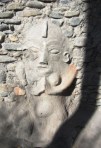 We also admire the graphically male and female effigies of the village gods who protected the village before Buddhism arrived. who is also endowed with genuine yak fur mustache and eyebrows, real teeth, a painted cloak and belt, and a real metal knife. The female effigy is about half the size of the male, and gets no paint or fur embellishment.
We also admire the graphically male and female effigies of the village gods who protected the village before Buddhism arrived. who is also endowed with genuine yak fur mustache and eyebrows, real teeth, a painted cloak and belt, and a real metal knife. The female effigy is about half the size of the male, and gets no paint or fur embellishment.
In the evening we all sit around a big table with a bunch of Germans and one Dutch girl enjoying the charcoal brazier warming our feet under the table, with our down jackets keeping us warm above the table, reluctant to leave in fear of the cold distance between charcoal brazier and sleeping bag. Despite the differences in languages and nationality around the table, we feel closer to these Europeans in outlook than to the folks who created and maintain both the village guardians and the Wheel of Life.
 The ecology and culture of the area has changed completely. Instead of blue guesthouses haphazardly cleaned and decorated with marigolds and Hindu shrines, we now have gleaming whitewashed homes with wood (a sign of wealth) piled on the roofs and Buddhist stupas appear at the entrance to each tiny town.
The ecology and culture of the area has changed completely. Instead of blue guesthouses haphazardly cleaned and decorated with marigolds and Hindu shrines, we now have gleaming whitewashed homes with wood (a sign of wealth) piled on the roofs and Buddhist stupas appear at the entrance to each tiny town.
Instead of banana trees we are now passing apple orchards, with the cored and peeled apple rings hung to dry on racks above the houses. (Question – why don’t birds eat them? Why aren’t there roof rats or other rodents to wreak destruction? Maybe the apples are exotic and the local fauna doesn’t recognize them as edible? A mystery.)
We had a lovely morning walk along the glacial green Kali Gulkhari river, encountering a group of German mountain bikers who enjoyed barreling across the suspension bridges. Then a tea break amid the apple orchards. The guides sorted through a bushel of apples and bagged the best to take with them – because area transportation is so spotty, these apples will be greeted as a luxury back in Pokhara.
 Then came a stretch of flat gray desolate land along the flood plain of the Kali Gulkhari: we crossed its tributaries on stepping stones and log bridges, waiting our turn with the oxen.
Then came a stretch of flat gray desolate land along the flood plain of the Kali Gulkhari: we crossed its tributaries on stepping stones and log bridges, waiting our turn with the oxen.
By the time we rejoined the bus road the wind and dust were picking up along the river. We left DB, one of the assistants, and all the large packs at one of the small villages to catch a jeep to Marfa while DM, the other three guides and I pressed on. We spotted DB’s jeep coming and I struggled with my trekking poles, grit in my eye from the wind and dust, and my camera in my right hand trying to take a picture; a sudden gust of wind seized my trusty Monterey Kayaks hat and swept it over the parapet and at least 100 feet straight down. Rats!
I used my Biffie to shield my scalp for the rest of the day’s walk, wide brimmed sunhats being scarce at the Tibetan craft shops on the way to Marfa.
 We reached Marfa just as the sun was setting beyond the mountains, leaving the town in dusky shade (and giving an unreal blue tinge to my photos. The white-washed stones and pale cobbles contrast with the heavy dark doorways and windows; the streets are so narrow that the houses seem to loom over the passersby. Where the casual litter of towns on the lower level leds to a feeling of congenial informality, in Marfa and other high-elevation towns there are communal sanctions for any shopkeeper who does not keep his shop in order and his share of sidewalk swept and neat. Even the dogs are well-behaved.
We reached Marfa just as the sun was setting beyond the mountains, leaving the town in dusky shade (and giving an unreal blue tinge to my photos. The white-washed stones and pale cobbles contrast with the heavy dark doorways and windows; the streets are so narrow that the houses seem to loom over the passersby. Where the casual litter of towns on the lower level leds to a feeling of congenial informality, in Marfa and other high-elevation towns there are communal sanctions for any shopkeeper who does not keep his shop in order and his share of sidewalk swept and neat. Even the dogs are well-behaved.
The guest house at Marfa gave us a lovely large room with big windows looking out at the mountains. 300 steps up from the guest house was a Buddhist monastery, with a lavishly painted shrine, cubbyholes for storing ancient religious scrolls, prayer flags fluttering everywhere. But there are only 20 or so monks in residence – it is hard to keep them, we were told – the young men keep leaving for warmer altitudes, busier throughways.